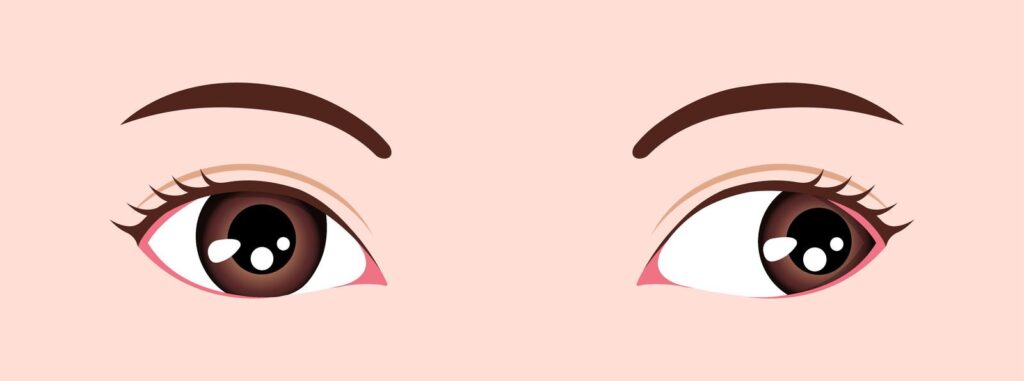Exotropia refers to a type of strabismus (eye misalignment) in which either one or both of the eyes turn outward.
It’s not the same as esotropia. In this condition, either one or both of the eyes turn inward.

Exotropia is a common condition. It accounts for 25 percent of all ocular misalignment cases in young children.3
While it could happen periodically, it could also be constant. However, it is more typical to find exotropia developed while a child is 1 to 4 years old.
Parents may notice this form of strabismus, especially when the child is:
- Daydreaming
- Sick
- Tired
It may also be apparent when the child attempts to focus on distant objects. When a child focuses on items up close, it may be difficult to notice the eye condition.
If there is suspicion of exotropia, it is essential to seek an eye care specialist. An eye doctor can perform a comprehensive eye exam and differential diagnosis to rule out other possible conditions.
Signs & Symptoms of Exotropia
Those with exotropia may experience some symptoms of exotropia or show signs.
For example, they may have:
- Loss of binocular vision
- Loss of depth perception
- Outward turning of the eyes. This can begin as intermittent
- Eyestrain
- Sensitivity to bright light or bright sunlight (this can cause people to squint)
These symptoms do not always suggest exotropia. However, it is essential to seek an eye consultation if one or more of these symptoms are present.
Different Types of Exotropia
There are 4 types of exotropia.
Speak with your ophthalmologist and undergo an eye exam to see which type of exotropia you or your child has.
1. Sensory Exotropia
If a person has sensory exotropia, the eye may suffer from poor vision or blindness. It will also turn outward.
Initially, if an infant or young child has a blind or poorly seeing eye, esotropia develops. However, in older children, the eye often becomes exotropic. These children are usually between the ages of 2 and 4 years.
2. Intermittent Exotropia
With intermittent exotropia, one eye turns outward on occasions.
Other times, the eyes are straight. During these times, there is no apparent suggestion of the condition. Family members or friends may observe the exotropia when the person with the disorder is either tired or daydreaming.
Intermittent exotropia may be more noticeable when the person looks at distant objects.
This type of exotropia is rare and will cause no to few symptoms. However, intermittent exotropia can occur more often or progress to becoming constant.
3. Congenital Exotropia
Some may refer to congenital exotropia as infantile exotropia. This outward turning of the eyes is present since birth or during early infancy.
While esotropia is more common in infants, a pediatric ophthalmologist should assess constant exotropia. The latter condition may link with an underlying medical condition.
4. Alternating Exotropia
People with an alternating exotropia have an outward eye turn that alternates both eyes. The condition can be constant or intermittent. It varies in degree of severity.
Intermittent exotropia is the most frequent type of strabismus. The condition impacts as much as 1 percent of the U.S. population.8 It is more common in females than in males.
Potential Complications of Exotropia
Exotropia can cause complications, including:
- Headaches
- Trouble reading
- Eyestrain
- Blurry vision
- Decreased 3D vision
- Abnormal head posture
More than 90 percent of children with intermittent exotropia develop myopia by 20 years of age.1
Listen In Q&A Format
Exotropia (Outward Turning Eyes)
Vision Center Podcast
What Causes Exotropia?
There is no specific, known cause of exotropia.
It may be common in children with either sensory exotropia or an underlying genetic disorder that affects eye movements.
Here is a list of some eye diseases that could increase the likelihood of developing exotropia:
- Duane’s syndrome — this is a congenital strabismus syndrome. People with the condition may experience diplopia (double vision), anisometropia (the two eyes have different refractive errors), and amblyopia (lazy eye).
- Slipped or lost medial rectus muscle — loss of this muscle can happen after different types of eye surgery. These eye surgeries include retinal detachment surgery or paranasal sinus surgery.
- Internuclear ophthalmoplegia — this is an ocular motility disorder. This condition affects the lateral gaze and causes ophthalmoplegia. This is paralysis or weakness of the eye muscles.
- Orbital fibrosis — this rare condition is characterized by an infiltrating orbital mass and thickening of connective tissue.
Additionally, these risk factors may increase the probability of exotropia:
- Family history of strabismus, amblyopia, childhood cataract, or glaucoma (increased eye pressure)
- Some genetic disorders. For example, cerebral palsy or Down syndrome
- Childhood cataracts or glaucoma
It is essential to understand that exotropia is not a disease in and of itself. The condition refers to a motility disturbance. This disturbance includes abnormal eye movements or trouble managing eye movements.
Exotropia can occur as a result of a particular medical disease or disorder.
How is Exotropia Diagnosed?
An eye doctor, such as an ophthalmologist or optometrist, will perform an exotropia diagnosis based on:
- Family history
- Symptoms
- Vision testing
Vision tests can consist of:
- Reading letters from an eye chart
- Refraction to test for uncorrected refractive error. In these cases, glasses may be prescribed
- Eye drops that dilate the pupils of the eyes and enable an exam of the eye’s internal structures
Treatment Options for Exotropia
Those with exotropia can explore both non-surgical and surgical treatment options.
Non-surgical treatment possibilities include:
- Patching
- Over-minused spectacles or glasses
- Orthoptic therapy. These exercises enable the re-education of binocular vision
- Prism glasses
Surgical treatments may be performed to maintain or restore binocular capability. Diplopia refers to double vision, while cosmesis means to enhance physical appearance.
There is a higher success rate in the long run for those with intermittent exotropia and with stronger binocular function at the time of surgery.
To learn which treatment is most suitable, you should visit your local eye clinic. There you can speak with a professional eye care specialist.
Is it Possible to Outgrow Intermittent Exotropia?
Intermittent exotropia may occur in infants as young as 1 to 2 months of age. If the condition is mild, it may go away on its own within 6 to 8 weeks of birth.
In other cases of exotropia, it is not common to find a complete resolution of the condition.
Patching, glasses, or vision therapy can help. However, exotropia may remain present.
In this article








